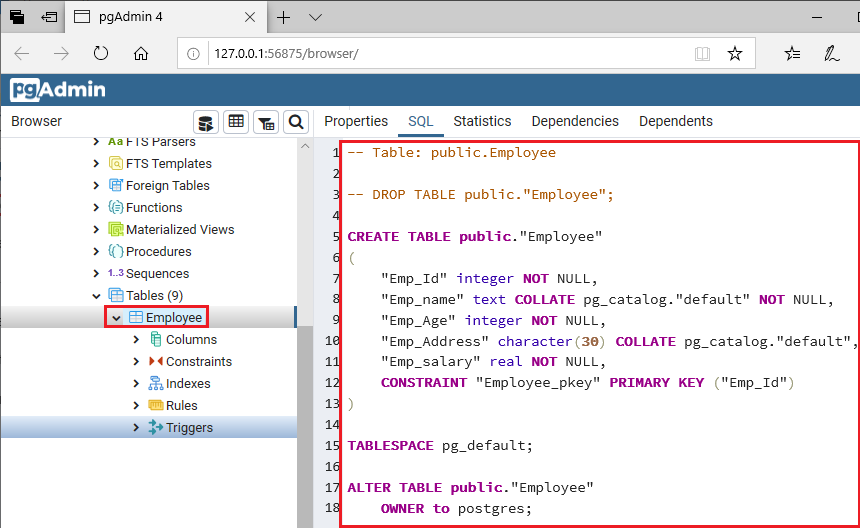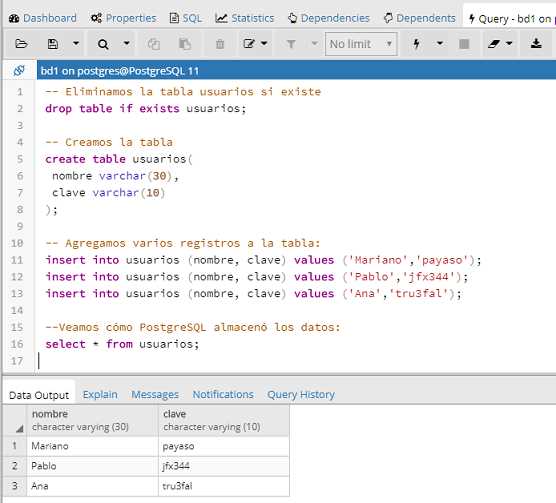

I don't like that nested dblink, but AFAIK I can't reference to tblB in dblink_exec body. If my understanding is correct (postgres has tbla and dbtest has tblb and you want remote insert with local select, not remote select with local insert as above): psql dbtest I just saw your revised question (closed as duplicate, or just very similar to this). You can make it as prepared statement if you want and it works as well: PREPARE migrate_data (integer) AS PostgreSQL has record pseudo-type (only for function's argument or result type), which allows you query data from another (unknown) table. INSERT INTO tblB (time) VALUES (5000), (2000) ĬREATE TABLE tblA (id serial, time integer) įROM dblink('dbname=dbtest', 'SELECT id, time FROM tblB') For example: psql dbtestĬREATE TABLE tblB (id serial, time integer) ON CONFLICT on constraint PK_EMP_ID DO NOTHING įor more information, see INSERT in the PostgreSQL documentation.As Henrik wrote you can use dblink to connect remote database and fetch result. ALTER TABLE EMPS ADD CONSTRAINT PK_EMP_ID PRIMARY KEY(employee_id)
#Postgresql insert into select update
The following example demonstrates using the ON DUPLICATE KEY UPDATE clause to update specific columns when a UNIQUE violation occurs. The following example isn’t compatible with PostgreSQL. INSERT INTO EMPS (EMPLOYEE_ID, FIRST_NAME, SALARY, DEPARTMENT_ID) SYSTEM VALUE is only for identity column where GENERATE ALWAYS exists if it’s not there and it was specified, then PostgreSQL just ignores it. The PostgreSQL INSERT statement allows you to insert a new row into a table. OVERRIDING is a new option since PostgreSQL 10 and relevant for identity columns. As an alternative, PostgreSQL provides the ON CONFLICT clause to capture errors, perform corrective measures, or log errors. Also, PostgreSQL doesn’t support the Oracle error_logging_clause. PostgreSQL INSERT FROM SELECT syntax is mostly compatible with the Oracle syntax, except for a few Oracle-only features such as the conditional_insert_clause ( ALL|FIRST|ELSE).


When inserting an existing EMPLOYEE ID into the EMPS table, the insert doesn’t fail because the invalid records are redirected to the ERRLOG table.įor more information, see INSERT in the Oracle documentation. The basic syntax of INSERT INTO SELECT is as follows: INSERT INTO table(column1, column2. LOG ERRORS INTO errlog ('Cannot Perform Insert') REJECT LIMIT 100

ALTER TABLE EMPS ADD CONSTRAINT PK_EMP_ID PRIMARY KEY(employee_id) ĮXECUTE DBMS_ERRLOG.CREATE_ERROR_LOG('EMPS', 'ERRLOG') Log errors with the Oracle error_logging_clause. (SELECT EMPLOYEE_ID, FIRST_NAME, SALARY, DEPARTMENT_ID FROM EMPS) This example produces the same result as the preceding example but uses a subquery in the DML_table_expression_clause. SELECT EMPLOYEE_ID, FIRST_NAME, SALARY, DEPARTMENT_ID INSERT INTO EMPS (EMPLOYEE_ID, FIRST_NAME, SALARY, DEPARTMENT_ID) SELECT EMPLOYEE_ID, SELECT INSERT SQL sql Copy INSERT INTO tbltemp2 (fldid) SELECT tbltemp1.fldorderid FROM tbltemp1 WHERE tbltemp1. The column ordering and data types must match between the target and the source tables. One can insert one or more rows specified by value expressions, or zero or more rows resulting from a query. You can insert multiple records into a table from another table using the INSERT FROM SELECT statement, which is a derivative of the basic INSERT statement.


 0 kommentar(er)
0 kommentar(er)
